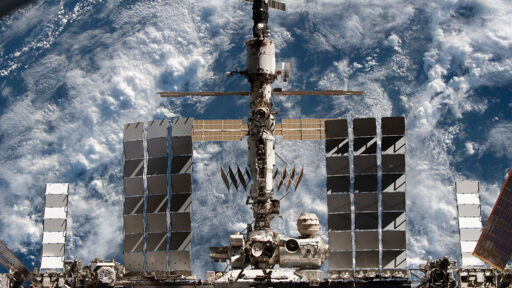The transfer tunnel, known by the Russian acronym PrK, connects the Zvezda module with a docking port where Soyuz crew and Progress resupply spacecraft attach to the station.
Air has been leaking from the transfer tunnel since September 2019. On several occasions, Russian cosmonauts have repaired the cracks and temporarily reduced the leak rate. In February, the leak rate jumped up again to 2.4 pounds per day, then increased to 3.7 pounds per day in April.
“The Russian position is that the most probable cause of the PrK cracks is high cyclic fatigue caused by micro-vibrations,” Cabana said on November 13. “NASA believes the PrK cracks are likely multi-causal, including pressure and mechanical stress, residual stress, material properties, and environmental exposures.”
Crew members aboard the space station are keeping the hatch leading to the PrK closed when they don’t need to access the Progress cargo freighter docked at the other end of the transfer tunnel. Russian cosmonauts must open the hatch to unpack supplies from the Progress or load trash into the ship for disposal.
As a precaution, Barratt said space station crews are also closing the hatch separating the US and Russian sections of the space station when cosmonauts are working in the PrK.
NASA: None of our engineerscan solve this problem.
HVAC guy: Hmm, can’t use soap bubbles in space… maybe if they use some smoke to make the leak visible…
What if the missing air was used by the extra people stranded by the starliner?
Doesn’t that throw off the trajectory over time?
Negligibly, they already lose significant enough altitude from the rare atmosphere up there to need to do boosts, but yes if it is a net force
It’s the I-SSsssssssssssssssssss
Because there’s a hole in it, stupid.
That’ll be five million dollar bucks for my consultation.
But the hole is on the Russian side and the Russian side is absolutely perfect. No holes here, Comrade, breathing is a luxury some people do not get. Do not become one of those non-breathers Comrade.
Line-item breakdown:
Fix-a-flat, $5.
Knowing where to squirt, $4,999,995.
Teenage me could have figured that out in a couple days, if you fire enough bullets eventually you’ve got to hit the target.
I’m a little surprised they don’t have, like, million-dollar lint, so it’ll tend toward the outflow points and clog them.
Ah, you mean G-lint, we make it from gold flecks because fuck you, oh and it keeps costs high and corrosiveness low.
Nonreactive, nonmagnetic, high-density, and preeetty.
✨ it’s Fabulous ✨
The ISS has been leaking air for 5 years, and engineers still don’t know why
*raises hand*
Uh, is it the cold unforgiving vacuum of space that forbids our existence there?
Sounds like earth now that you describe it.
Space doesn’t really have a temperature as you need something to be hot or cold! And in the vacuum there isn’t much.
So just unforgiving vacuum.
My brain just imploded from that realisation and it troubles me.
I can intellectually reconcile what you said, but my reptilian brain cannot comprehend the phenomenon for whatever reason.
I instinctively don’t believe that the radiation only is how heat is transferred in the vacuum even though I know that this the case. We always have had 3 (convection, conduction and radiation), and that stumps me.
Heat transfer by radiation complicates things. We lose the majority of our heat that way, and we’d lose a lot more if every cubic inch of the spaces we inhabit weren’t flooded with thermal radiation from the objects that surround us.
You can absolutely judge the temperature of a volume, vacuum or not, by its radiation content at any given moment.
You’re describing a thermal balance. Temperature is a property of matter which doesn’t exist in a perfect vacuum. That said, the space around ISS is far from a perfect vacuum (atomic oxygen sucks). In any case, the typical temperature model starts to breakdown with increasing vacuum.
Sure, but in any practical sense it is a temperature. It would be silly to say space isn’t cold (or hot depending) from a regular person’s perspective. Thermal balance creates an effective temperature, even if it wouldn’t be described as a temperature within some technical frame of reference.
That’s a fair point.
Fill the ISS with water and you’ll be able to see the leak.
This is probably the dumbest thing I’ve heard. You clearly have no idea what you’re taking about. To find the leak they need to spray the outside with soapy water. If that doesn’t work the next step is to put the ISS in a bathtub and fill the bathtub with water
Idiot. You obviously have no idea about the logistics of launching a bath into space. You’d need to send a bucket on a rocket (aero dynamic).
Put the ISS into the bucket, fill with water, then squeeze the ISS and look for bubbles.
Fucking fools. Just use a robotic arm to bend the whole suspect section. You’ll see the cracks open up as you flex it back and forth, and can spray some flex seal in the cracks. Seriously, try a little bit.
Brainless hemroids! Shmear the conspicuous gelatinous substance from front to back, always from front to back. Freshen & powder, and wrap her back up before she starts spewing like a little lad.
Great now there’s an 1800’s sailor on the space station.
I’m gonna show you ninnies how to really skip this boat
What a bunch of morons. Just hang some clothes around the ISS and if they wave you’ve found your leak. No need to send anything because astronauts already have clothes up there …
You all are fools, all this time finding the leak and none of you brought the tire patch
Clearly you’re thinking with your feet, because if you used your brain you’d know you bring the ISS to the bathtub, not the other way around
Ah, so after the ISS deorbit vehicle dunks it in the South Pacific, we can patch the hole and put it on the ISS reorbit vehicle. Right?
Just cover the exterior with soapy water
“The ISS is leaking?? Where?”
“It’s high overhead, orbiting the earth at tremendous speed. But that’s not important right now.”
Airplane?
No, space station
Surely?
Yes, it is a space station, and don’t call me Shirley.
I just wanted to say good luck, and we’re all counting on you.
Airplane!
“ISS! More like H-ISS! amirite?!”
The lack of an H is part of the French contribution to the station.
It’s not a leak, it’s a leaqu’est
They just need to get their hands on HRAs to keep the hiss at bay. Where’s Dr. Darling??
Out there looking like dynanite
Someone needs to close the damn window, we aren’t paying to heat the entire universe
Question: When Air leaks from the ISS, does it just orbit with it indefinitely as an “air bubble” or maybe a dispersed “air cloud” around it or will it eventually settle down into the atmosphere?
In a vacuum, gas will expand indefinitely, so they probably become stray atoms of gas, that will orbit for a little, ocassionallt hitting each other and probably eventually falling back in the atmosphere.
Have they tried lighting a match and following the smoke?
Hot box the ISS! We need to train stoners to be astronauts so the can come save the day!
Cheesy Aerosmith music intensifies
That’s going to need a lot of flex tape.






